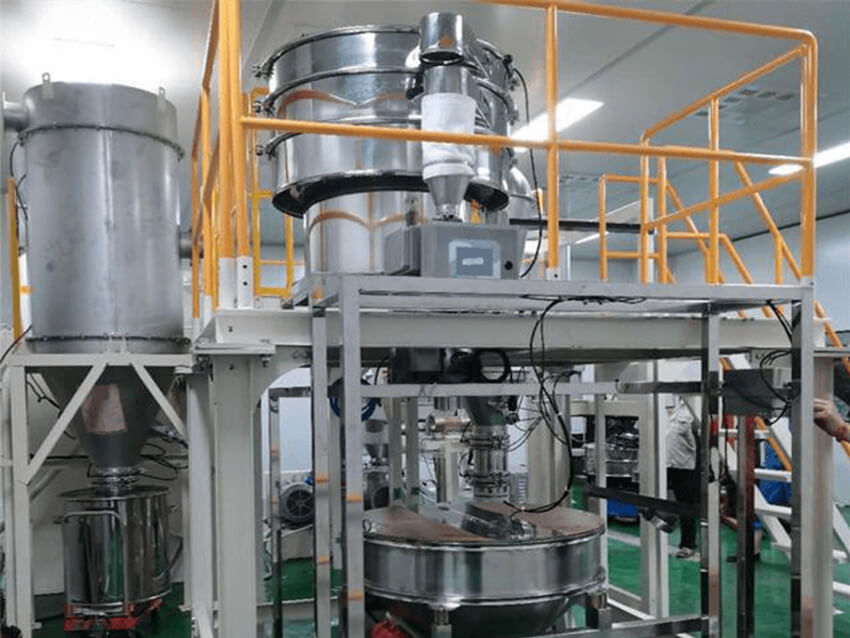
Fluidity and adhesion: Due to its chemical properties, dicyandiamide may have a certain degree of adhesion, especially under adverse conditions (such as high humidity or static electricity), and measures should be taken to control the ambient humidity and anti-static to ensure smooth screening.
Fragility and wear resistance: Dicyandiamide particles should show moderate fragility and wear resistance during the screening process. Excessive fragility may cause the particles to break during the screening process, affecting the particle size distribution and purity of the product; while excessive wear resistance may increase the wear of the screen and shorten the service life of the equipment. Therefore, it is necessary to select appropriate screen materials and screening parameters to protect material properties and equipment performance.
Impurity content and removal efficiency: One of the main purposes of the screening process is to remove impurities in dicyandiamide, such as unreacted raw materials, by-products and mechanical impurities. The presence of these impurities will seriously affect the purity and performance of the product. The use of dust-free feeding stations and dust removal equipment can effectively reduce dust flying, improve the cleanliness of the screening environment, thereby enhancing the removal efficiency of impurities and improving the purity of the product.
Screening mesh: According to product specifications and application requirements, the screening mesh is generally set between 10-50 mesh. This range can not only meet the particle size requirements of most customers, but also effectively remove fine impurities.
Processing capacity: Considering production efficiency and equipment capacity, the processing capacity of the screening link is usually set to 1-3 tons/hour. This processing capacity can not only ensure the continuity of production, but also avoid failures and downtime caused by equipment overload.
The production of dicyandiamide usually involves multiple steps, including raw material preparation, reaction synthesis, cooling crystallization, solid-liquid separation, drying and subsequent treatment. In each link, product quality needs to be strictly controlled to ensure that the purity and performance of the final product meet market demand. Among them, screening, as one of the key steps, is of great significance for improving product purity, removing impurities, and achieving particle size classification.
The equipment required for the dicyandiamide screening production line is mainly determined by the purpose of screening, the characteristics of the material and the scale of production. The following are some core equipment that may be required and their characteristics:
Screening Equipment:
Vortex screen: This is one of the commonly used equipment in the dicyandiamide screening process. The vortex screen uses a vibration motor as the excitation source, and the material is vibrated to form a jumping forward on the screen, thereby achieving efficient screening. It has a simple structure, convenient operation, high screening efficiency, and is easy to clean and maintain. The rotary vibrating screen equipped with an ultrasonic system can handle ultrafine powder materials and meet the classification and impurity removal requirements of dicyandiamide and other similar materials.
Auxiliary Equipment:
Dust-free feeding station: mainly used for automatic feeding and dust removal of materials, which can effectively reduce the flying dust during the feeding process, improve the production environment, and ensure the health and safety of operators. Used in conjunction with screening equipment, it can further improve screening efficiency and product quality.
Conveying equipment: such as belt conveyors, screw conveyors, etc., used to transport materials from storage bins or other equipment to screening equipment. These equipment can ensure the continuity and stability of materials during transportation and avoid blockage or damage of materials during transportation.
Dust removal equipment: such as bag dust collectors, cyclone dust collectors, etc., used to handle dust and exhaust gas generated during screening to ensure the cleanliness and environmental protection requirements of the production environment.
Measuring equipment: such as electronic scales, flow meters, etc., used to accurately measure the input amount of materials and the output of screening products for production management and quality control.
The screening process is graded and impurities are removed, and the mesh size and processing volume are accurately set to meet the diverse needs of the market.
The rotary vibrating screen is efficient and easy to maintain, and is an ideal choice for screening operations to ensure production continuity and stable quality.
Cooperate with the dust-free feeding station to improve efficiency, improve the environment, and ensure health.
The screening process design reflects the ultimate pursuit of quality and market response, and enhances the market competitiveness of products.
Thirty years of dedication have allowed us to accumulate extensive production and service experience, enabling us to solve various challenges in powder processing for our numerous clients.
Innovation is the lifeblood of our company's development. To date, we have obtained over 40 domestic and international patents, with many of our products holding multiple patents.
We specialize in undertaking the design and production of fine powder processing production lines, offering a one-stop service from crushing, screening, conveying, feeding, mixing to packaging.
Upon receipt of the products, detailed English user manuals are provided. For relatively complex installations or product usage, video installation guidance is available. For large-scale technical projects, we can dispatch professional technical personnel for on-site installation guidance.
 Please fill in the informationWe provide you with personalized solutions
Please fill in the informationWe provide you with personalized solutionsIf you do not know how to select, please call us or leave a message online. We will serve you wholeheartedly!